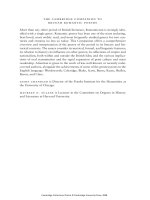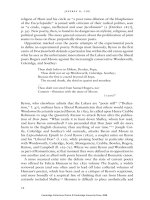The cambridge companion to british roman 46
Bạn đang xem bản rút gọn của tài liệu. Xem và tải ngay bản đầy đủ của tài liệu tại đây (38.59 KB, 1 trang )
j e f f r e y n . c ox
religion of Hunt and his circle as “a poor tame dilution of the blasphemies
of the Encyclopædie” is joined with criticism of their radical politics, seen
as “a crude, vague, ineffectual and sour Jacobinism” (2 [October 1817],
p. 39). New poetry, then, is found to be dangerous on stylistic, religious, and
political grounds. The more general concern about the proliferation of print
seems to focus on these purportedly obscure poets.
Opposition marked even the poetic attempts of the experimental poets
to define an experimental poetry. Perhaps most famously, Byron in the first
canto of Don Juan both defends a particular line within the old canon against
what he sees as the unfortunate innovations of the Lakers and sets the liberal
poets Rogers and Moore against the increasingly conservative Wordsworth,
Coleridge, and Southey:
Thou shalt believe in Milton, Dryden, Pope;
Thou shalt not set up Wordsworth, Coleridge, Southey;
Because the first is crazed beyond all hope,
The second drunk, the third so quaint and mouthey:
...
Thou shalt not steal from Samuel Rogers, nor
Commit – flirtation with the muse of Moore.
(1.205)21
Byron, who elsewhere admits that the Lakers are “poets still” (“Dedication,” l. 47), outlines here a liberal Romanticism that others would reject.
Wordsworth certainly rejected Byron. In 1820, he called upon Henry Crabbe
Robinson to urge the Quarterly Review to attack Byron after the publication of Don Juan: “What avails it to hunt down Shelley, whom few read,
and leave Byron untouched? I am persuaded that Don Juan will do more
harm to the English character, than anything of our time.”22 Joseph Cottle, Coleridge and Southey’s old comrade, attacks Byron and Moore in
his Expostulatory Epistle to Lord Byron (1820), a couplet satire on Byron
and his “Liberal Don” (l. 110), while praising Southey in particular along
with Wordsworth, Coleridge, Scott, Montgomery, Crabbe, Bowles, Rogers,
Barton, and Campbell (ll. 162–75). Where we unite Byron and Wordsworth
as part of Romanticism, at that moment they were defined as in opposition to
one another and as allied with poets beyond the standard Romantic canon.
A more nuanced entry into the debate over the state of current poetry
was offered by Felicia Hemans in her 1820 volume The Sceptic, a widely
reviewed poem (and one often used to lead off later collected volumes of
Hemans’s poetry), which has been read as a critique of Byron’s scepticism,
and more broadly of a sceptical line of thinking that ran from Hume and
certainly included Shelley.23 Hemans is difficult to place aesthetically and
24
Cambridge Collections Online © Cambridge University Press, 2008









